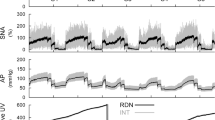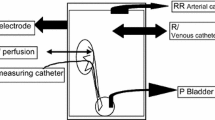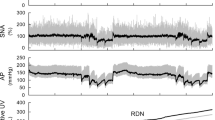Abstract
Conscious, chronically instrumented dogs, maintained on a high sodium intake, were used to investigate whether surgical cardiac denervation impairs the natriuresis associated with left atrial pressure increase produced in three ways: during an increase in left atrial pressure by means of a reversible mitral stenosis (protocol 1); after an i.v. saline load (1.0 ml 0.9%·saline min−1·kg−1 over 60 min) (protocol 2); after an oral saline load (14.5 mmol Na·kg−1 given with the food as an isotonic solution) (protocol 3).
During a reversible mitral stenosis, in intact dogs, urine volume and sodium excretion increased markedly (from 34–145 μl·min−1·kg−1 and from 3–12 μmol·min−1·kg−1); mean arterial pressure increased by an average of 2 kPa (15 mm Hg) and heart rate by 55 b/min; plasma renin activity fell from 0.37–0.21 ng Al·ml−1·h−1. Cardiac denervation eliminated these effects of left atrial distension except for a small increase in heart rate (12 b/min). This indicates that the natriuresis and diuresis during left atrial distension resulted from stimulation of receptors located in the left atrium.
In contrast, during protocol 2 and 3, the same amounts of sodium and water were excreted in the cardiac denervated dogs as compared to the intact dogs. A comparable decrease in plasma renin activity also was observed. — Apparently the presence of the cardiac nerves is not a prerequisite for maintenance of sodium and water homeostasis.
Similar content being viewed by others
References
Behrenbeck DW, Reinhardt HW (1967) Untersuchungen an wachen Hunden über die Einstellung der Natriumbilanz. II. Postprandiale Elektrolyt- und Wasserbilanz bei unterschiedlicher Kochsalzzufuhr. Pflügers Arch Ges Physiol 295:280–292
Drake AJ, Stubbs J, Noble MIM (1978) Dependence of myocardial blood flow and metabolism on cardiac innervation. Cardiovasc Res 12:69–80
Fater DC, Sundet WD, Schultz HD, Goetz KL (1980) Cardiac denervation eliminates the diuretic response elicited by increasing left atrial pressure with a balloon. Fed Proc 39:3592 (Abstract)
Gauer OH, Henry JP (1976) Neurohormonal control of plasma volume. Int Rev Physiol Cardiovasc Physiol II 9:145–190
Gilmore JP, Daggett WM (1966) Response of the chronic cardiac denervated dog to acute volume expansion. Am J Physiol 210:509–512
Goetz KL, Bond GC, Bloxham DD (1975) Atrial receptors and renal function. Physiol Rev 55:157–205
Guyton AC (1976) Regulation of arterial pressure: II. The renal-body fluid system for long-term pressure control. The mechanisms of hypertension. In: Guyton AC (ed) Textbook of medical physiology, chapter 22. WB Saunders Comp, Philadelphia London Toronto, pp 279–294
Haber E, Koerner T, Page LB, Kliman B, Purnode A (1969) Application of a radioimmunoassay for angiotensin I to the physiologie measurements of plasma renin activity in normal human subjects. J Clin Endocr 29:1349–1355
Henry JO, Pearce JW (1956) The possible role of cardiac atrial stretch receptors in the induction of changes in urine flow. J Physiol 131:572–585
Johnson JA, Moore WW, Segar WE (1969) Small changes in left atrial pressure and plasma antidiuretic hormone titers in dogs. Am J Physiol 217:210–214
Johnson MD, Malvin RL (1977) Stimulation of renal sodium reabsorption by angiotensin II. Am J Physiol 232:F298–306
Kaczmarczyk G, Eigenheer F, Gatzka M, Kuhl U, Reinhardt HW (1978) No relation between atrial natriuresis and renal blood flow in conscious dogs. Pflügers Arch 373:49–58
Kaczmarczyk G, Mohnhaupt R, Simgen B, Reinhardt HW (1980) Postprandial (pp) volume regulation and renin-angiotensin system (RAS) in conscious dogs. Proc Int Union Physiol Sci 14:0327
Kaczmarczyk G, Schimmrich B, Mohnhaupt R, Reinhardt HW (1979) Atrial pressure and postprandial volume regulation in conscious dogs. Pflügers Arch 381:143–150
Kaczmarczyk G, Unger V, Mohnhaupt R, Reinhardt HW (1981) Left atrial distension and intrarenal blood flow distribution in conscious dogs. Pflügers Arch 390:44–48
Keck W, Brechtelsbauer H, Kramer K (1969) Wasser- und Natriumausscheidung nach isotonen Kochsalz-Infusionen bei wachen Hunden mit verschiedenem Natriumbestand. Pflügers Arch 311:119–130
Keck W, Joppich R, v Restorff WD, Finsterer U, Prucksunand P, Brechtelsbauer H, Kramer K (1973) Sodium excretion in conscious and anesthetized dogs after large saline infusions. Pflügers Arch 341:51–62
Knox FG, Davis BB, Berliner RW (1967) Effect of chronic cardiac denervation on renal response to saline infusion. Am J Physiol 213:174–178
Lydtin H, Hamilton WF (1964) Effect of acute changes in left atrial pressure on urine flow in unanesthetized dogs. Am J Physiol 207:530–536
McDonald KM, Rosenthal A, Schrier RW, Galicich J, Lauler DP (1970) Effect of interruption of neutral pathways on renal response to volume expansion. Am J Physiol 218:510–517
Reinhardt HW, Behrenbeck DW (1967) Untersuchungen an wachen Hunden über die Einstellung der Natriumbilanz. I. Die Bedeutung des Extracellulärraumes für die Einstellung der Natrium-Tagesbilanz. Pflügers Arch Ges Physiol 295:266–279
Reinhardt HW, Eisele R, Kaczmarczyk G, Mohnhaupt R, Oelkers W, Schimmrich B (1980a) The control of sodium excretion by reflexes from the low pressure system independent of adrenal activity. Pflügers Arch 384:171–176
Reinhardt HW, Kaczmarczyk G, Eisele R, Eigenheer F, Kuhl U (1977) Left atrial pressure and sodium balance in conscious dogs on a low sodium intake. Pflügers Arch 370:59–66
Reinhardt HW, Kaczmarczyk G, Mohnhaupt R, Simgen B (1980b) Atrial natriuresis under the condition of a constant renal perfusion pressure — Experiments on conscious dogs — Pflügers Arch 389:9–15
Thoren P (1979) Role of cardiac vagal c-fibers in cardiovascular control. Rev Physiol Biochem Pharmacol 86:1–94
Wegener S, Kaczmarczyk G, Schimmrich B, Mohnhaupt R, Reinhardt HW (1978) Suppression of atrial natriuresis after acute and chronic reduction of total body sodium (TBS). Experiments on conscious dogs on a high or a low sodium intake. Pflügers Arch Suppl 377:60
Wiberg I, Vaage J, Scott E (1979) Release of prostaglandin-like substances during elevations of left atrial pressure in the cat. Acta Physiol Scand 107:97–103
Zehr JE, Hasbargen JA, Kurz KD (1976) Reflex suppression of renin secretion during distension of cardiopulmonary receptors in dogs. Circ Res 38:232–239
Author information
Authors and Affiliations
Rights and permissions
About this article
Cite this article
Kaczmarczyk, G., Drake, A., Eisele, R. et al. The role of the cardiac nerves in the regulation of sodium excretion in conscious dogs. Pflugers Arch. 390, 125–130 (1981). https://doi.org/10.1007/BF00590194
Received:
Accepted:
Issue Date:
DOI: https://doi.org/10.1007/BF00590194




